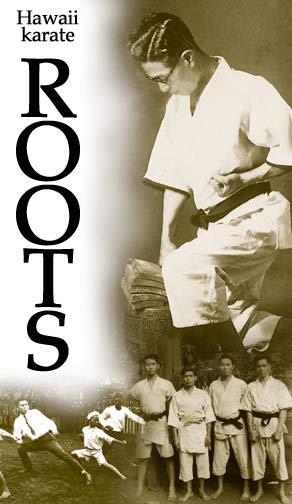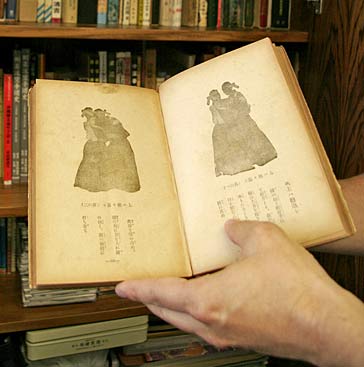
|
A collector offers a public display
of his artifacts documenting
the martial art's history in
Hawaii before World War II
Although Charles Goodin has studied a variety of martial arts for most of his life, he has developed a distinct passion for karate.
Hawaii Karate
|
Goodin's fascination with the art has led him to collect more than 10 years' worth of artifacts and information on karate in Hawaii before World War II.
His Hawaii Karate Museum and the Japanese Cultural Center of Hawaii are putting on an exhibit to honor the pioneers of karate and provide more information about an important aspect of the Asian-American experience in Hawaii. "Hawaii Karate Roots: 105 Years of Karate in Hawaii" will be the first martial arts exhibit at the cultural center's community gallery, from tomorrow to Aug. 19.
"This exhibit will give names and faces to the pioneers of karate in Hawaii," Goodin said. "If today's karate students knew more about their pioneers, they would be truly humbled and gain a deeper understanding each and every time they practiced the art."
Goodin's collection of 130 photos, 12 rare books and 60 articles will document the arrival of karate in Hawaii with the first 26 Okinawan immigrants and the visits of prominent instructors to the islands, including Kentsu Yabu (1927), Choki Motobu (1932), Mizuho Mutsu (1933), Kamesuke Higashionna (1933) and Chojun Miyaji (1934).
Some of the photographs will be on display for the first time, and picture Okinawan and Japanese instructors who helped to bolster interest in the art and lead people of other ethnicities to study it.
The exhibit will also present many rare karate weapons, such as a "tonfa" (police baton), "sai" (hand-held metal trident-shaped sword), "nunchaku" (nunchuck), "tobikuchi" (fireman's iron ax with handle), "yawara" (symmetrical 12-inch wooden stick) and "kusarigama" (a 9- to 12-foot chain connecting an iron weight to a single-edge blade mounted to a wooden handle).

Charles Goodin, president of the Hikari Institute, holds up a "tobikuchi," or fireman's pick, which became a weapon in the hands of a karate practitioner.
Although Goodin does not speak or read Japanese, he has managed to locate many articles and advertisements about karate in Hawaii before World War II. He found the dates of prominent sensei (instructor) visits, then he memorized the kanji characters for "karate" and spent countless Sundays in the University of Hawaii's Hamilton Library microfilm room, sifting through old Japanese publications for karate articles.
Goodin still receives donations from family and friends of karate sensei.
"We won't be able to see this unless we save it now," he said. "There's no end to research. ... What we're showing is a lot, but I know there's a lot more out there."
Modern karate derives from a simplified version that was taught on a wide scale in Japan and to U.S. troops during World War II.

Charles Goodin holds up an old karate book, part of a collection taking up two bookcases.
Goodin said karate was part of an Okinawan curriculum that made "cultured citizens" who learned values such as respect, self-control and dedication and applied them to daily life.
"We still practice the ancient tradition of removing our shoes and bowing to show respect to our elders before entering the dojo," said 14-year-old Aiea resident Christine Choy. "Then, before we start the class, Sensei often shares anecdotes and stories about the history of karate and its pioneers so we respect them and what they have done for us."
Along with many of the modern forms of karate, Goodin said Choy has perfected one of the longest "katas" (movement sequences) involving the "bo" (staff).
He added that karate fundamentals are still taught in preset forms, which preserves the sequence of movements across generations.
"Katas are named after the people who created them, so we are honoring them each time we practice it," he said.
Goodin suggests prospective students look into their local recreational centers and Buddhist temples offering classes.
"People should observe a class, note the number of participants and consider the goals and values of the class before committing to a specific dojo," Goodin added. "I think it is beneficial to study any martial art, as long as it helps them become better people."
Karate’s history in HawaiiKarate was discreetly practiced in homes and back yards exclusively within the Okinawan community in the early 1900s, said Charles Goodin, owner of the Hawaii Karate Museum. Most Western researchers did not know whom they should talk to or that the practice even existed, Goodin said.Karate did not become prominent in Hawaii until the 1930s, after several prominent karate masters visited Hawaii and promoted the art to people outside the Okinawan community through public displays and karate clubs. Karate's popularity subsided during World War II, when anything related to Japanese culture was discouraged. After the war, karate experienced a second wave of popularity when American soldiers who served on Okinawa brought the martial art back with them to Hawaii.
|
Hikari.us
E-mail to City Desk
[News] [Business] [Features] [Sports] [Editorial] [Do It Electric!]
[Classified Ads] [Search] [Subscribe] [Info] [Letter to Editor]
[Feedback]
